The 13 Most Impressive Animals in Venezuela
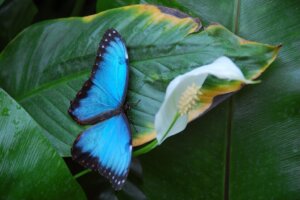
Venezuela is one of the 17 most megadiverse countries in the world, being abundant in endemic species. Its territorial extension of 916,050 square kilometers is home to impressive animals such as colorful birds, imposing mammals, unique amphibians and majestic insects. To get to know them, let’s take a tour through a paradise of diversity, with jungles, mountain ranges, coasts, dunes and plains. Get ready to discover some of the most representative animals in Venezuela!
Most impressive animals in Venezuela
1. Venezuelan troupial (Icterus icterus)

The troupial has been the national bird of Venezuela since 1958. It belongs to the icterid family and is distinguished by its black plumage on wings and head, yellow on the body, and white in a thin line on its wings. It can reach between 15 and 22 centimeters in size (6 to 9 inches).
Its melodious song can be heard at dawn -and continues during the day- in warm areas such as savannahs and gallery forests, where it usually lives. This bird bases its diet on fruits, insects and berries. This contributes to seed dispersal and the control of populations of these small arthropod invertebrates.
2. Amazon river dolphin (Inia geoffrensis)
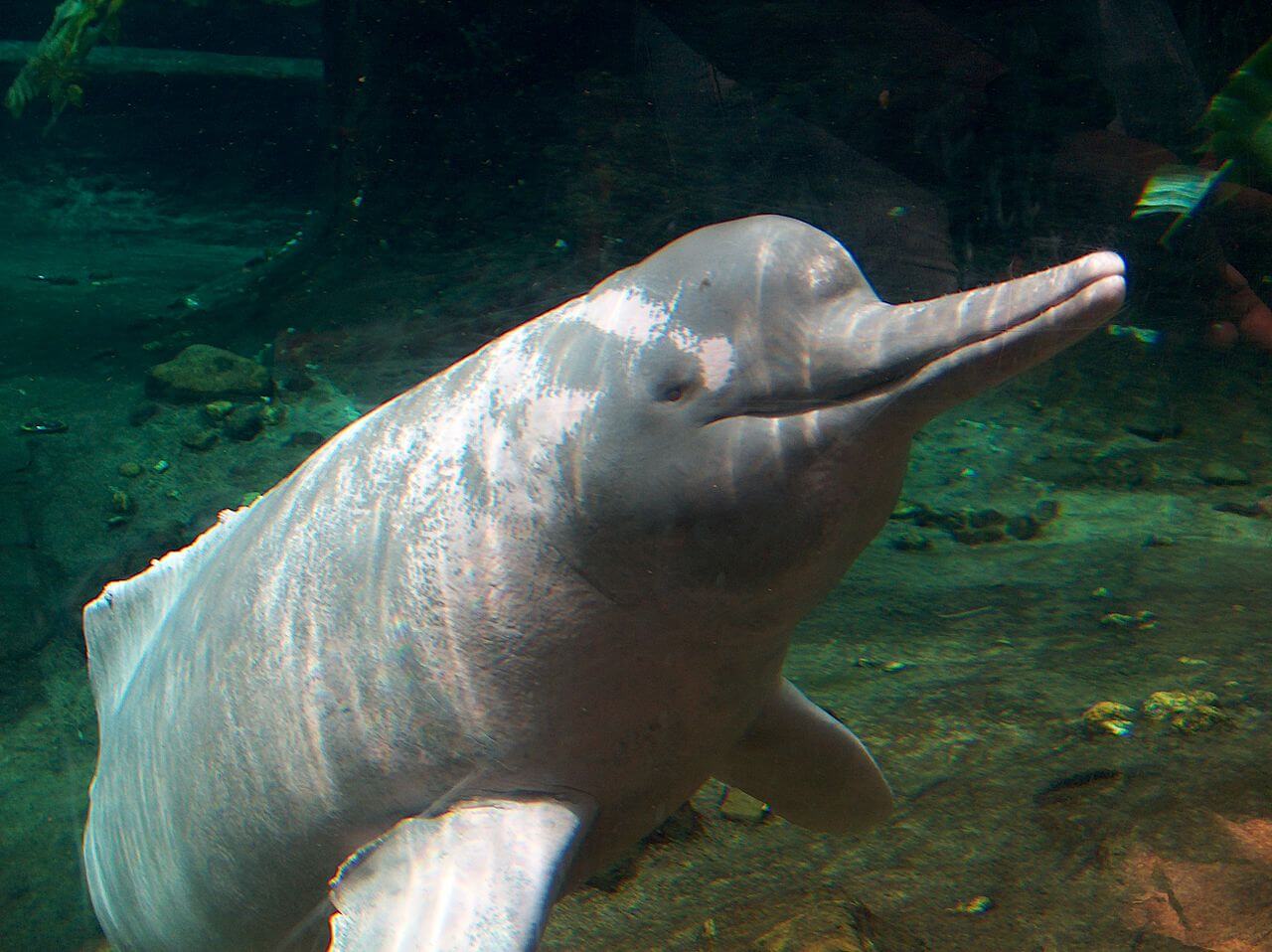
The Amazon river dolphin is the largest freshwater dolphin on the planet. It inhabits the Amazon and Orinoco river basins, as well as their tributaries. The average weight of females is 100 kilograms (220 pounds) and their length is up to 2.18 meters (7.1 feet), while males weigh 154 kilograms (340 feet) and can reach up to 2.55 meters (8.36 feet) in length.
Their diet includes small fish, as well as crustaceans (crabs and shrimp).
The distinctive color of their body depends on their age. Juveniles are characterized by a dark gray, while adults acquire a pink hue. Interestingly, males tend to be pinker than females. The Animal Diversity Web specifies that coloration is subject to variables such as the following:
- Temperature
- Geographical location
- Water clarity
3. Spectacled bear (Tremarctos ornatus)
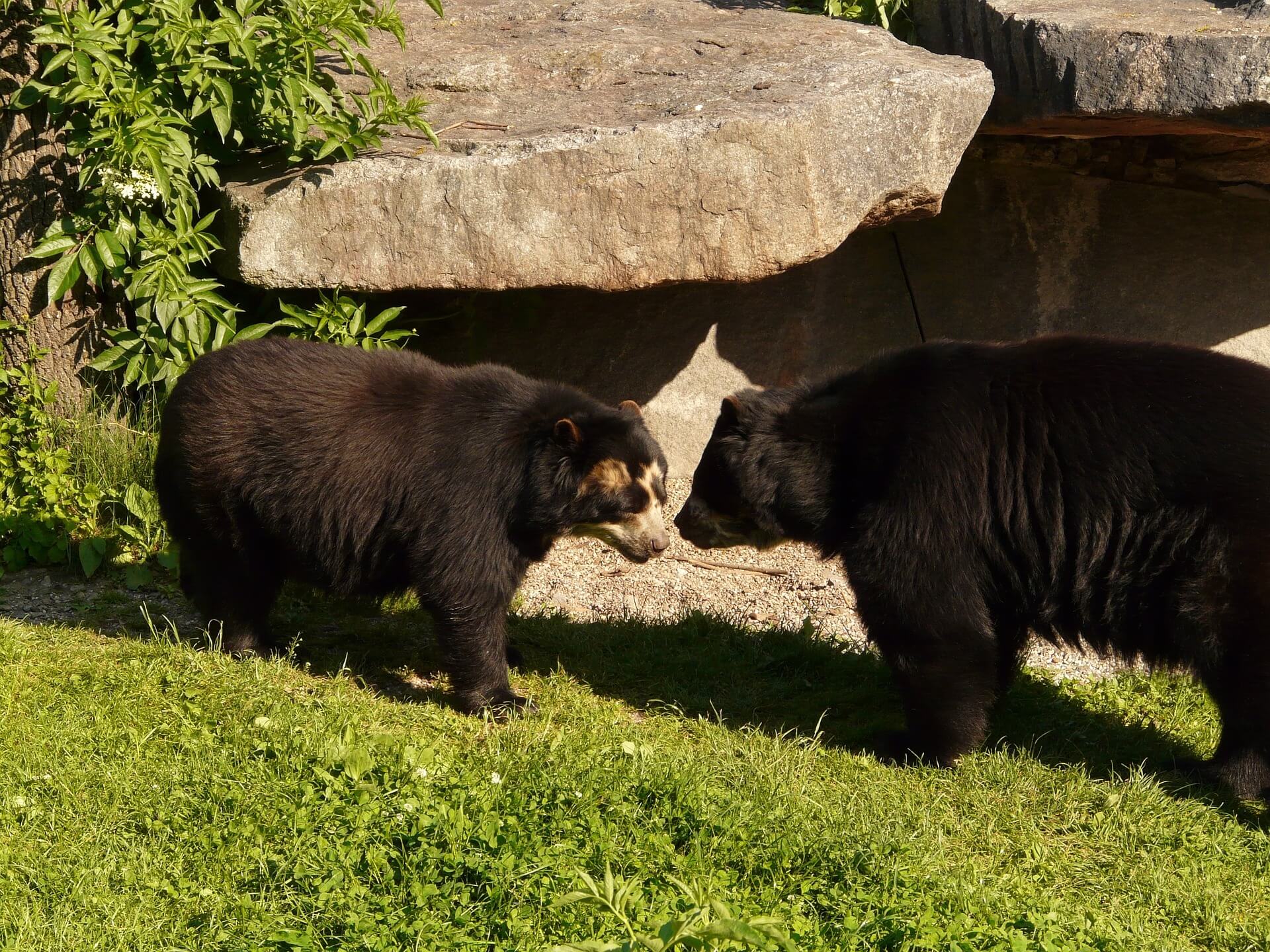
This mammal is the only endemic bear in South America and the only living species of the subfamily Tremarctinae. It inhabits the Andes mountain range, from the high Andean region of Venezuela to northern Argentina.
This bear is classified as “vulnerable” by the International Union for Conservation of Nature (IUCN), due to hunting because of misinformation – as many people believe it to be dangerous – or even superstitions. However, for several indigenous cultures, it’s a sacred animal.
4. West Indian manatee (Trichechus manatus)
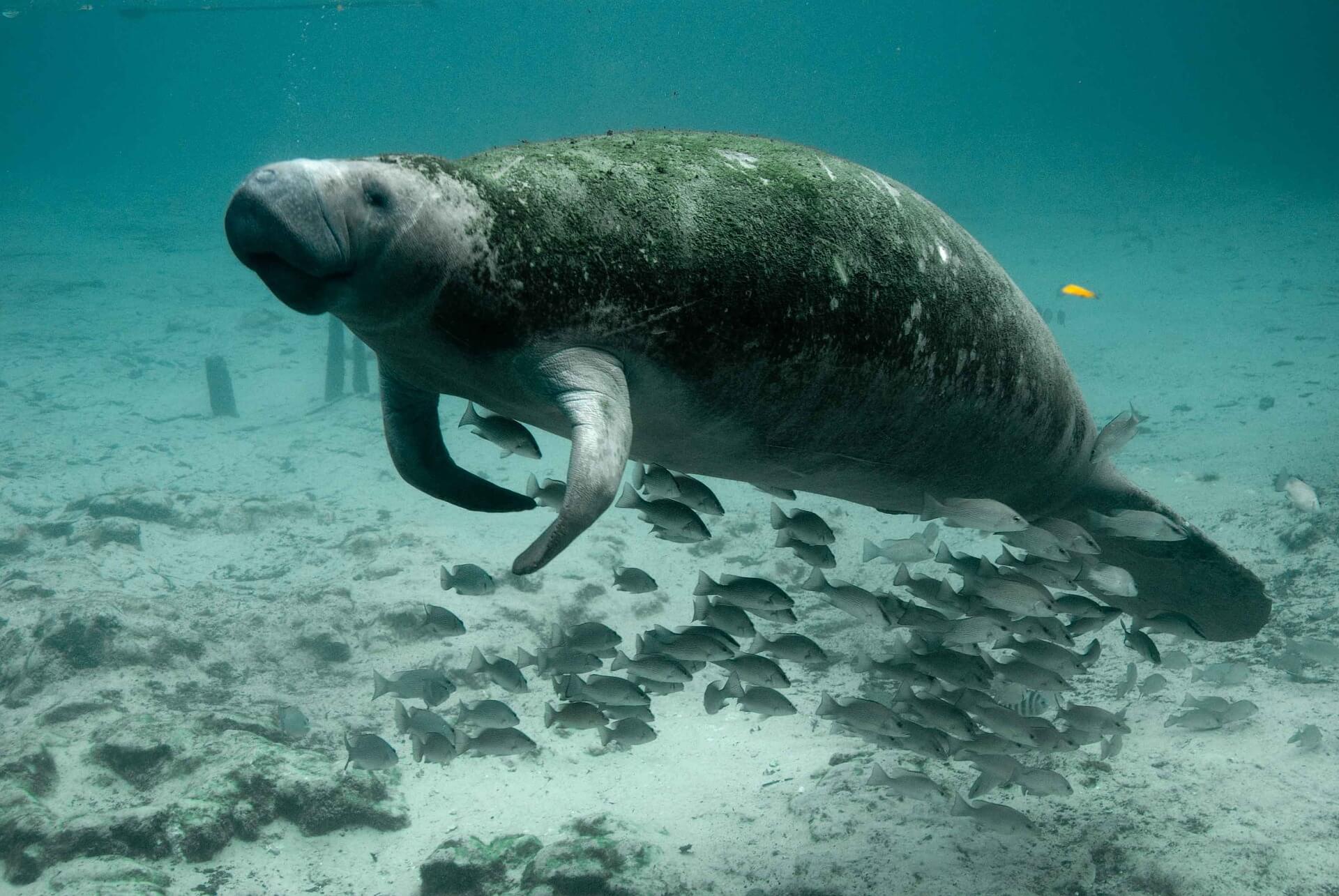
The sea cow or manatee is a sirenian that adapted to the aquatic environment. According to an article published in the PeerJ magazine, the oldest fossil of these animals has an average age of 47 million years and lived in northwestern Africa.
The subspecies found in Venezuela has the scientific name Trichechus manatus manatus.
It inhabits the Maracaibo Lake basin, the Orinoco River, and the Paria Gulf. This mammal is herbivorous; it feeds on mangrove leaves and consumes 15-20% of its body weight every day.
The West Indian manatee is considered a “vulnerable” species of extinction, according to the IUCN. Among the threats it faces are the following:
- Destruction of its habitat
- Entanglement in fishing nets
- Illegal hunting
- Collision with motorboats
5. Red siskin (Spinus cucullatus)
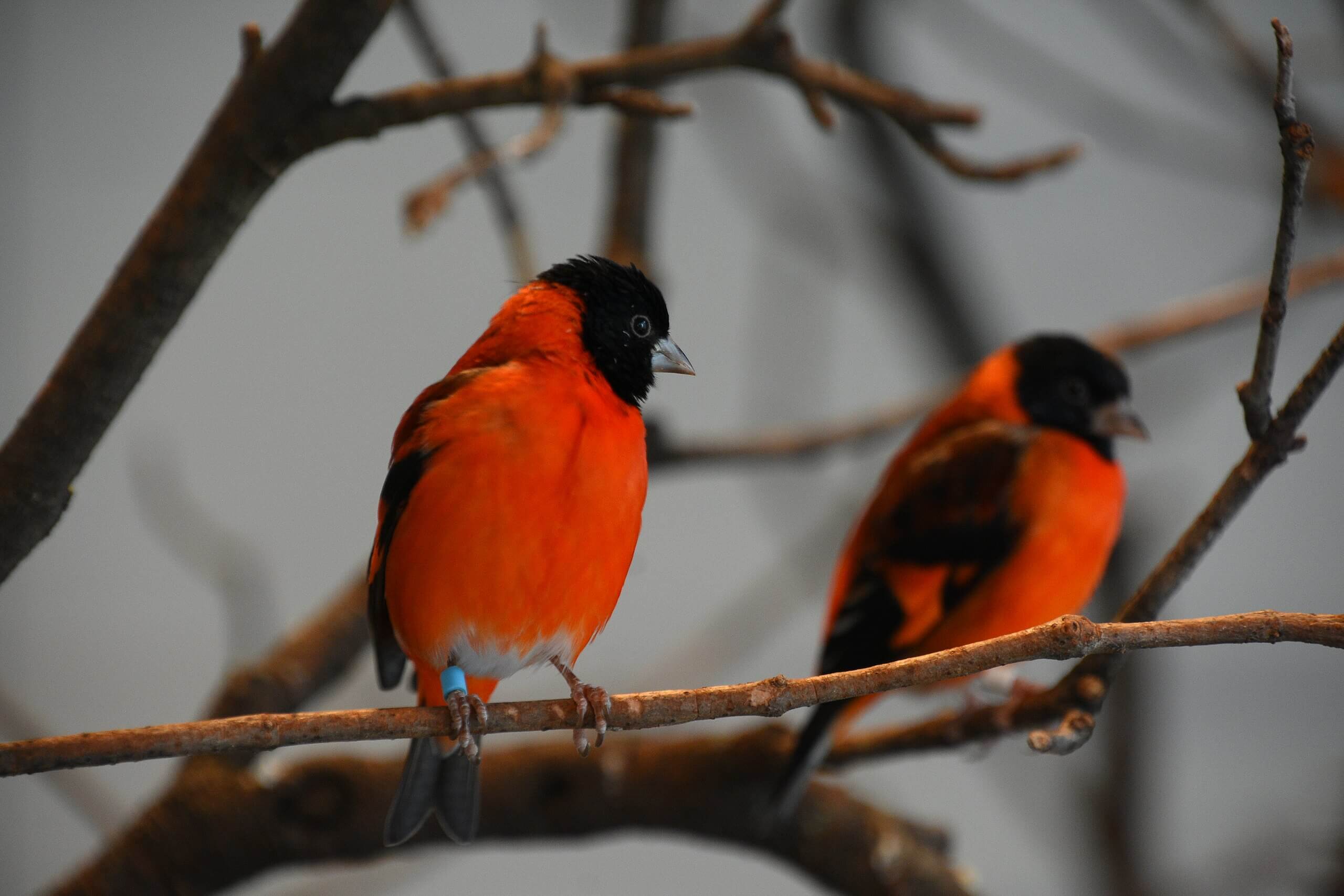
This small bird, native to northern South America, is native to Venezuela. Small populations also exist in Colombia and Guyana. It’s considered extinct on Monos Island in neighboring Trinidad and Tobago.
According to the IUCN list, it’s an “endangered” species. Regarding the Venezuelan population of red siskins, this international organization has estimates ranging from 250 to 1000 individuals, without discarding other more encouraging estimates of up to 4000 birds.
Its situation is so worrying that if the capture and trade of Spinus cucullatus isn’t controlled, it could disappear in the not-too-distant future.
6. Capybara (Hydrochoerus hydrochaeris)

The capybara is the world’s largest rodent. The variety of names by which it’s known is due to the fact that it lives in almost all of South America. It’s found in forests, as well as in tropical and temperate savannahs. This species inhabits the Venezuelan plains and is characterized by being very sociable.
7. Common blue morpho (Morpho helenor Cramer)
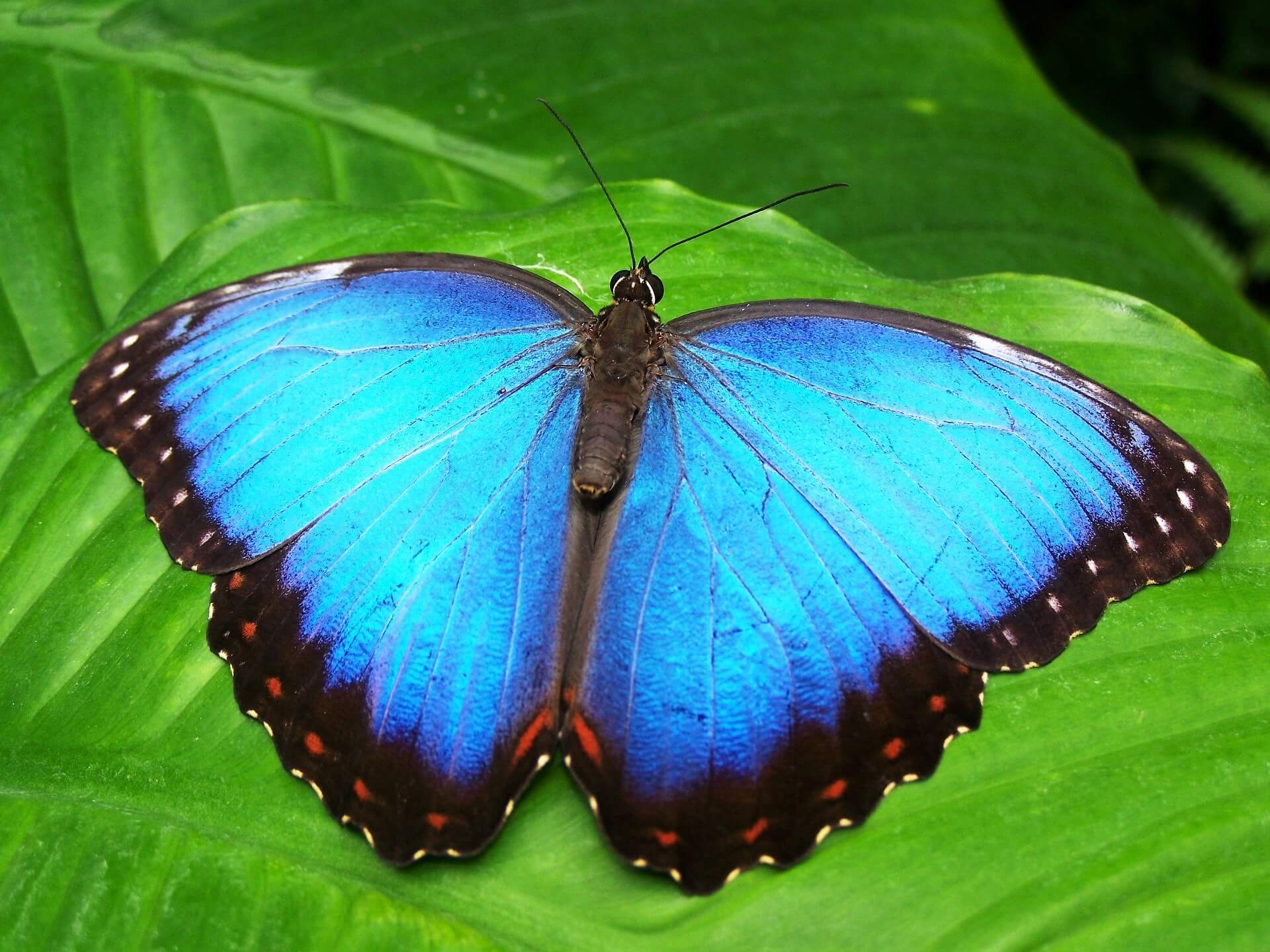
This Neotropical butterfly, of the order Lepidoptera and family Nymphalidae, is characterized by its iridescent blue, although they aren’t actually that color. In reality, this striking hue is the result of light reflecting off the scales of their wings. Their wingspan can reach between 12.5 and 20 centimeters (5 to 8 inches).
They’re native to Central and South America. Their home is the forests, where they usually live alone, except during the mating season. The Morpho butterfly has a life cycle of about 137 days, from egg to death.
In 2019, the Museum of the Institute of Agricultural Zoology “Francisco Fernández Yépez” conducted a survey where it won the title of National Butterfly of Venezuela.
8. Harpy eagle (Harpia harpyja)
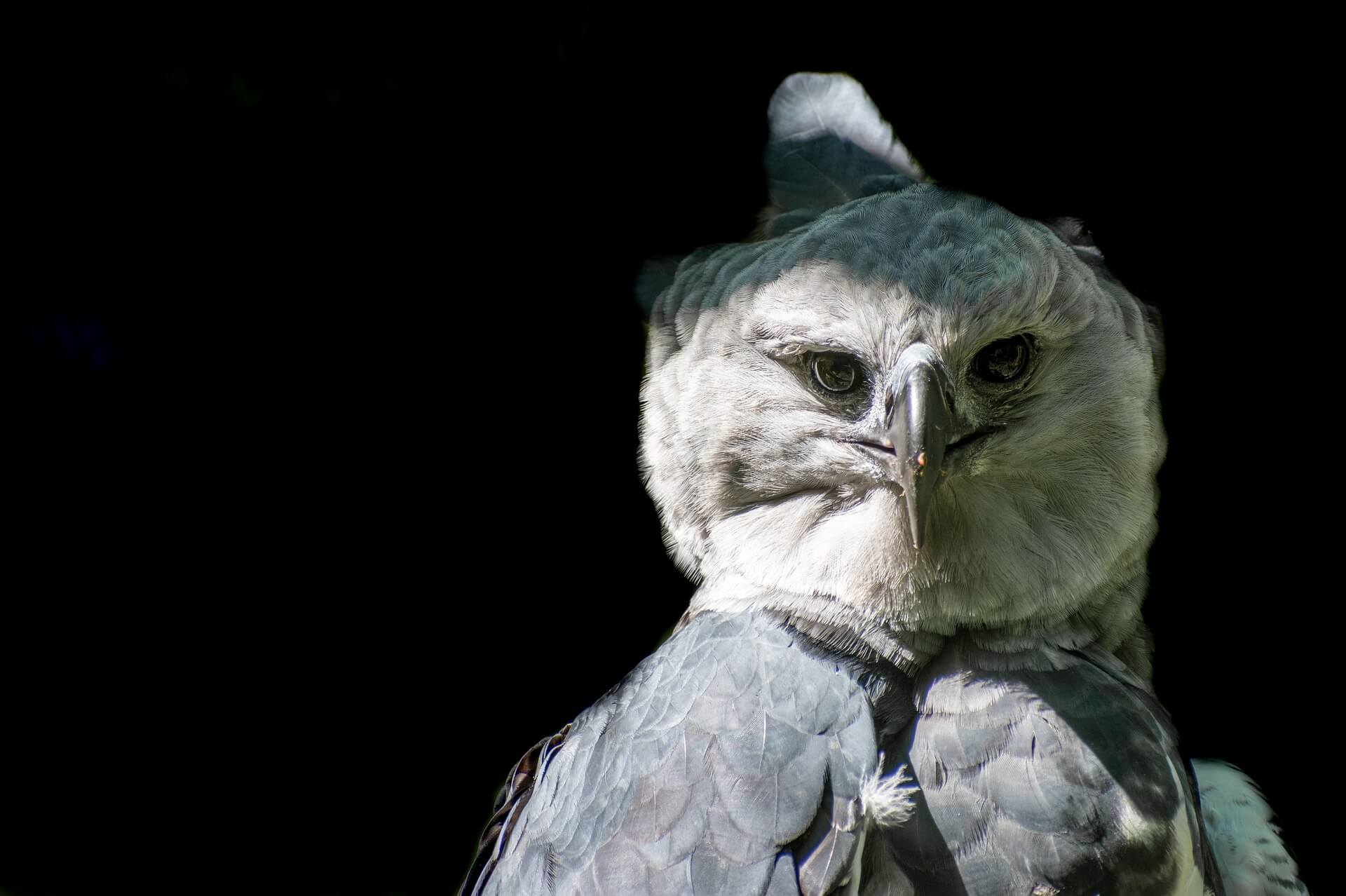
The harpy eagle is the largest of Venezuela’s accipitrid species (diurnal birds of prey). At an international level, the IUCN classifies it as a “vulnerable” species because forest degradation, hunting, and persecution are causing its population to decline.
In Venezuela, this bird is found in the Perijá mountain range, south of Lake Maracaibo, in the Cordillera de la Costa Central, as well as in the states of Monagas, Delta Amacuro, Amazonas, and Bolívar.
The harpy eagle is one of the most impressive animals in Venezuela. The most striking physical characteristic of the harpy eagle is its striking crest of gray plumage. This bird’s body can reach up to one meter (3.3 feet) in height and its wingspan can be up to two meters (6.6 feet).
9. Giant anteater (Myrmecophaga tridactyla)
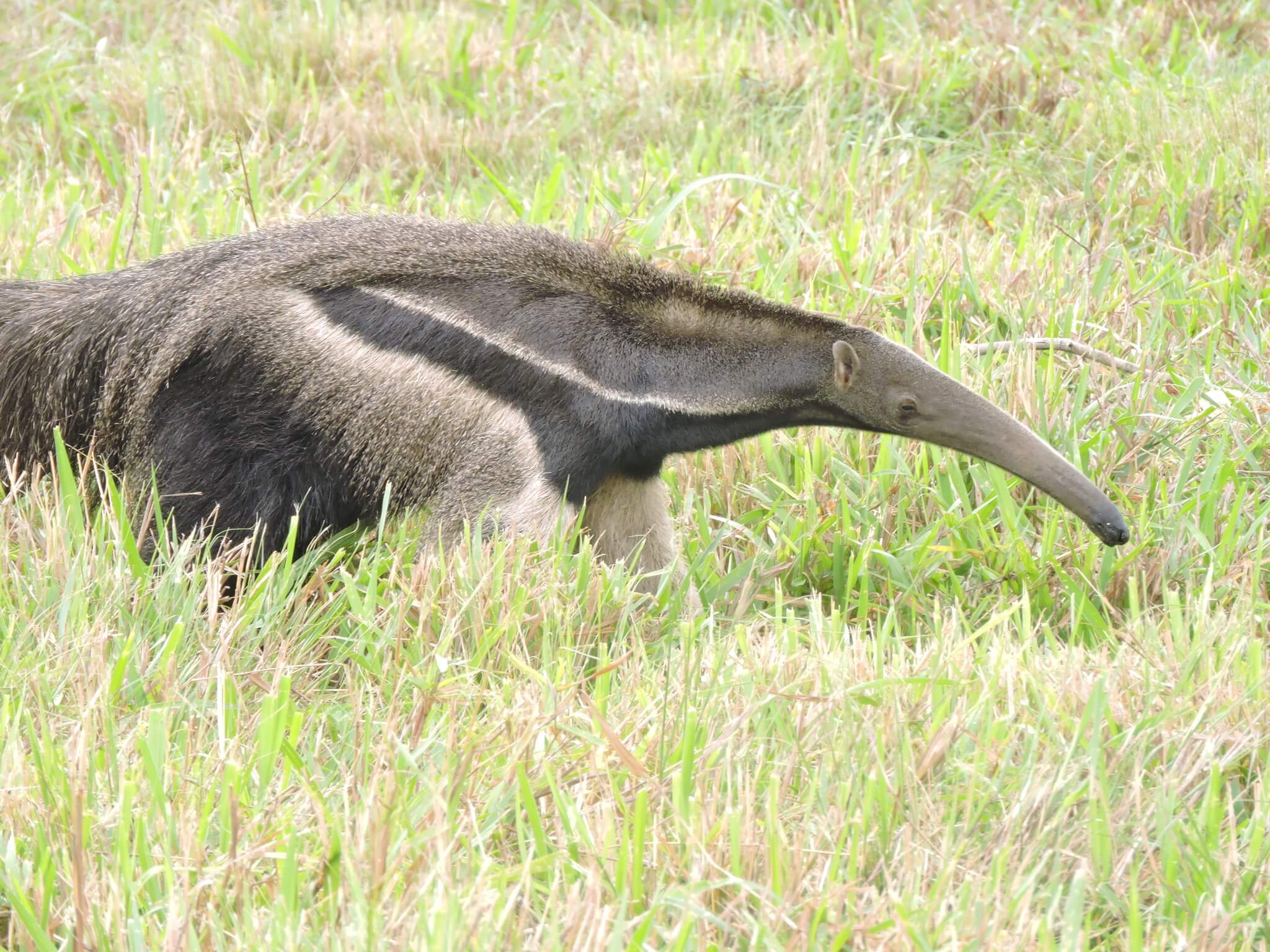
Out of all the anteaters, this is undoubtedly the largest. Its distribution covers the lowland forests and savannas of countries such as Colombia, Ecuador, Guyana, Peru, Brazil, Bolivia, Paraguay, Uruguay, Argentina, and Venezuela. This mammal is in the “vulnerable” category of the IUCN list, due to habitat destruction, fires, and hunting.
10. White-tailed sabrewing (Campylopterus ensipennis)

This bird is endemic to Venezuela and is found in northeastern Venezuela, as well as on the nearby islands of Trinidad and Tobago. As its name implies, this large hummingbird has an almost completely white tail, a downward-curved bill, a blue throat, and a green body.
11. Ocelot (Leopardus pardalis)
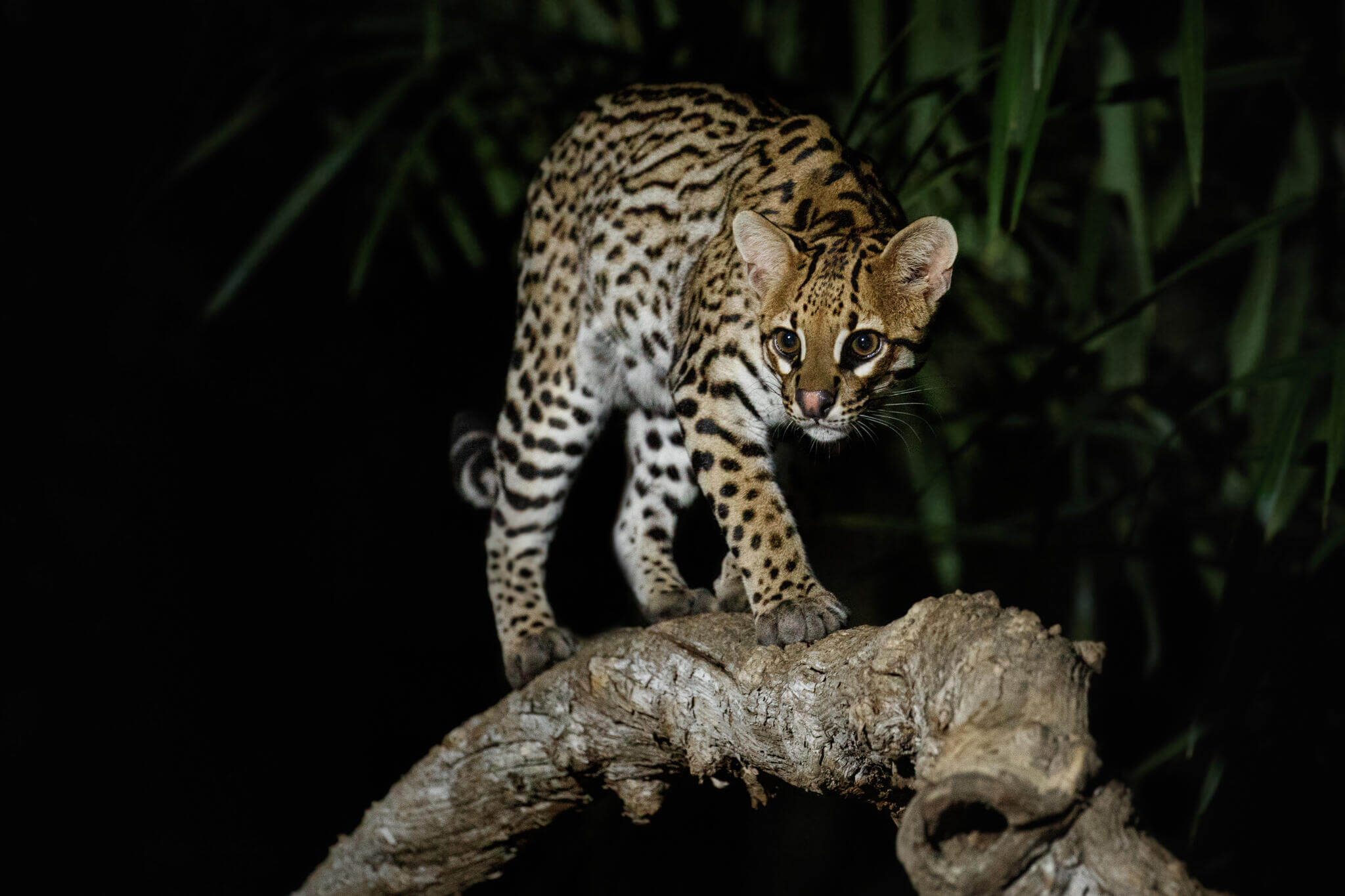
It’s the largest feline of the genus Leopardus. Its size ranges from 40 to 45 centimeters (16 to 18 inches) tall and its length can reach 70 to 100 centimeters (2.3 to 3.3 feet). The coat is yellowish-brown in color, with irregular dark spots, which are like fingerprints on each individual.
The ocelot lives alone and feeds on mammals, birds and small reptiles. It’s usually found in savannas, thorn, and forests, as well as mangroves and scrublands.
12. Scarlet ibis (Eudocimus ruber)
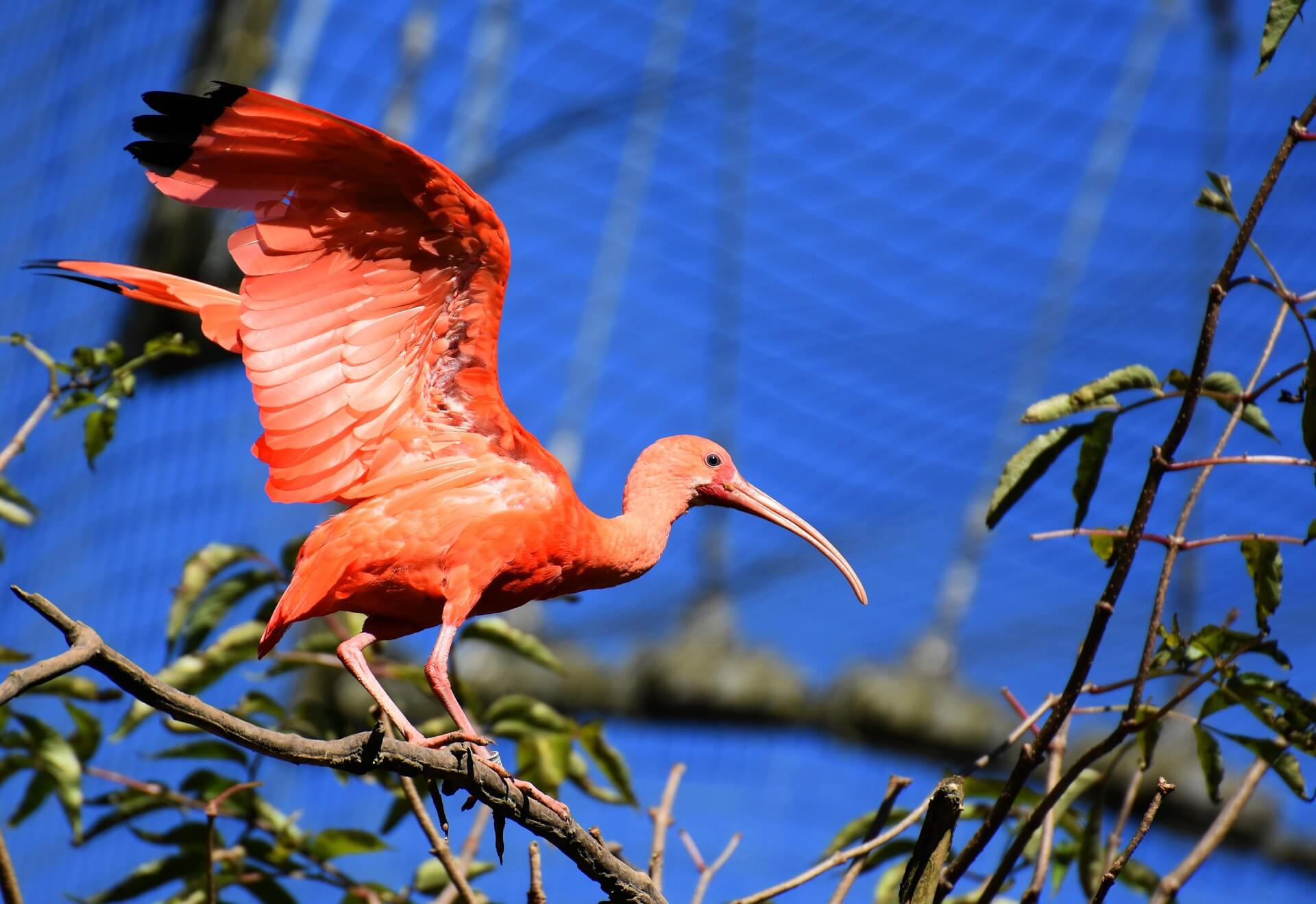
The characteristic red color of its plumage is due to pigments from the crustaceans they feed on. Their wing tips are black and their beak is pink, long and curved. However, this structure may turn black in males during the breeding period.
This bird is native to South America. It inhabits swampy areas of the Orinoco basin in the north of this Caribbean country. It’s also found in Colombia, Brazil and the Guianas.
13. Yellow-banded poison dart frog (Dendrobates leucomelas)
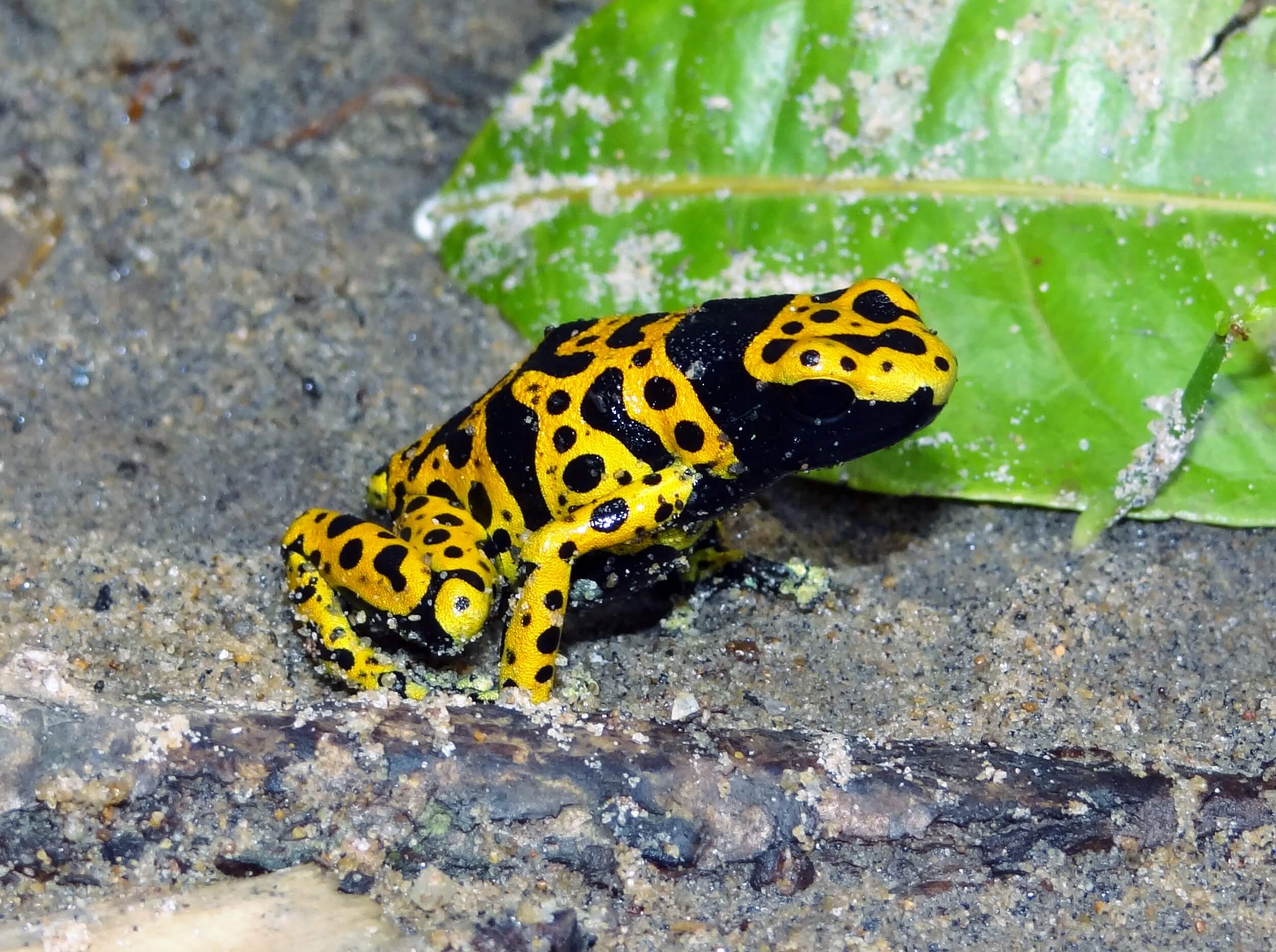
This small amphibian is one of the most impressive animals in Venezuela because of its coloration. It belongs to the Dendrobatidae family of arrowhead frogs. Its striking combination of black and yellow is a warning of its toxicity, although, in reality, this relatively low.
This aposematic species ranges in length from 30 to 38 millimeters.
Breeding occurs during the rainy season. It inhabits tropical rainforests in the Amazon region of Venezuela. It’s also found in eastern Colombia, northern Brazil, and western Guyana.
Call for the conservation of species
This compilation can’t capture all the diversity and vitality of the animals in Venezuela. Jaguars, macaws, toucans, Orinoco caimans, and other species are also among the most impressive animals in Venezuela.
However, many of the species mentioned in this article are endangered or vulnerable. To contribute to their conservation, we should find out about the impact of human activities on biodiversity.
In addition, it’s essential to respect protected areas and not to buy products derived from exotic species. In this way, we’ll be promoting the preservation of nature.
Venezuela is one of the 17 most megadiverse countries in the world, being abundant in endemic species. Its territorial extension of 916,050 square kilometers is home to impressive animals such as colorful birds, imposing mammals, unique amphibians and majestic insects. To get to know them, let’s take a tour through a paradise of diversity, with jungles, mountain ranges, coasts, dunes and plains. Get ready to discover some of the most representative animals in Venezuela!
Most impressive animals in Venezuela
1. Venezuelan troupial (Icterus icterus)

The troupial has been the national bird of Venezuela since 1958. It belongs to the icterid family and is distinguished by its black plumage on wings and head, yellow on the body, and white in a thin line on its wings. It can reach between 15 and 22 centimeters in size (6 to 9 inches).
Its melodious song can be heard at dawn -and continues during the day- in warm areas such as savannahs and gallery forests, where it usually lives. This bird bases its diet on fruits, insects and berries. This contributes to seed dispersal and the control of populations of these small arthropod invertebrates.
2. Amazon river dolphin (Inia geoffrensis)

The Amazon river dolphin is the largest freshwater dolphin on the planet. It inhabits the Amazon and Orinoco river basins, as well as their tributaries. The average weight of females is 100 kilograms (220 pounds) and their length is up to 2.18 meters (7.1 feet), while males weigh 154 kilograms (340 feet) and can reach up to 2.55 meters (8.36 feet) in length.
Their diet includes small fish, as well as crustaceans (crabs and shrimp).
The distinctive color of their body depends on their age. Juveniles are characterized by a dark gray, while adults acquire a pink hue. Interestingly, males tend to be pinker than females. The Animal Diversity Web specifies that coloration is subject to variables such as the following:
- Temperature
- Geographical location
- Water clarity
3. Spectacled bear (Tremarctos ornatus)

This mammal is the only endemic bear in South America and the only living species of the subfamily Tremarctinae. It inhabits the Andes mountain range, from the high Andean region of Venezuela to northern Argentina.
This bear is classified as “vulnerable” by the International Union for Conservation of Nature (IUCN), due to hunting because of misinformation – as many people believe it to be dangerous – or even superstitions. However, for several indigenous cultures, it’s a sacred animal.
4. West Indian manatee (Trichechus manatus)

The sea cow or manatee is a sirenian that adapted to the aquatic environment. According to an article published in the PeerJ magazine, the oldest fossil of these animals has an average age of 47 million years and lived in northwestern Africa.
The subspecies found in Venezuela has the scientific name Trichechus manatus manatus.
It inhabits the Maracaibo Lake basin, the Orinoco River, and the Paria Gulf. This mammal is herbivorous; it feeds on mangrove leaves and consumes 15-20% of its body weight every day.
The West Indian manatee is considered a “vulnerable” species of extinction, according to the IUCN. Among the threats it faces are the following:
- Destruction of its habitat
- Entanglement in fishing nets
- Illegal hunting
- Collision with motorboats
5. Red siskin (Spinus cucullatus)

This small bird, native to northern South America, is native to Venezuela. Small populations also exist in Colombia and Guyana. It’s considered extinct on Monos Island in neighboring Trinidad and Tobago.
According to the IUCN list, it’s an “endangered” species. Regarding the Venezuelan population of red siskins, this international organization has estimates ranging from 250 to 1000 individuals, without discarding other more encouraging estimates of up to 4000 birds.
Its situation is so worrying that if the capture and trade of Spinus cucullatus isn’t controlled, it could disappear in the not-too-distant future.
6. Capybara (Hydrochoerus hydrochaeris)

The capybara is the world’s largest rodent. The variety of names by which it’s known is due to the fact that it lives in almost all of South America. It’s found in forests, as well as in tropical and temperate savannahs. This species inhabits the Venezuelan plains and is characterized by being very sociable.
7. Common blue morpho (Morpho helenor Cramer)

This Neotropical butterfly, of the order Lepidoptera and family Nymphalidae, is characterized by its iridescent blue, although they aren’t actually that color. In reality, this striking hue is the result of light reflecting off the scales of their wings. Their wingspan can reach between 12.5 and 20 centimeters (5 to 8 inches).
They’re native to Central and South America. Their home is the forests, where they usually live alone, except during the mating season. The Morpho butterfly has a life cycle of about 137 days, from egg to death.
In 2019, the Museum of the Institute of Agricultural Zoology “Francisco Fernández Yépez” conducted a survey where it won the title of National Butterfly of Venezuela.
8. Harpy eagle (Harpia harpyja)

The harpy eagle is the largest of Venezuela’s accipitrid species (diurnal birds of prey). At an international level, the IUCN classifies it as a “vulnerable” species because forest degradation, hunting, and persecution are causing its population to decline.
In Venezuela, this bird is found in the Perijá mountain range, south of Lake Maracaibo, in the Cordillera de la Costa Central, as well as in the states of Monagas, Delta Amacuro, Amazonas, and Bolívar.
The harpy eagle is one of the most impressive animals in Venezuela. The most striking physical characteristic of the harpy eagle is its striking crest of gray plumage. This bird’s body can reach up to one meter (3.3 feet) in height and its wingspan can be up to two meters (6.6 feet).
9. Giant anteater (Myrmecophaga tridactyla)

Out of all the anteaters, this is undoubtedly the largest. Its distribution covers the lowland forests and savannas of countries such as Colombia, Ecuador, Guyana, Peru, Brazil, Bolivia, Paraguay, Uruguay, Argentina, and Venezuela. This mammal is in the “vulnerable” category of the IUCN list, due to habitat destruction, fires, and hunting.
10. White-tailed sabrewing (Campylopterus ensipennis)

This bird is endemic to Venezuela and is found in northeastern Venezuela, as well as on the nearby islands of Trinidad and Tobago. As its name implies, this large hummingbird has an almost completely white tail, a downward-curved bill, a blue throat, and a green body.
11. Ocelot (Leopardus pardalis)

It’s the largest feline of the genus Leopardus. Its size ranges from 40 to 45 centimeters (16 to 18 inches) tall and its length can reach 70 to 100 centimeters (2.3 to 3.3 feet). The coat is yellowish-brown in color, with irregular dark spots, which are like fingerprints on each individual.
The ocelot lives alone and feeds on mammals, birds and small reptiles. It’s usually found in savannas, thorn, and forests, as well as mangroves and scrublands.
12. Scarlet ibis (Eudocimus ruber)

The characteristic red color of its plumage is due to pigments from the crustaceans they feed on. Their wing tips are black and their beak is pink, long and curved. However, this structure may turn black in males during the breeding period.
This bird is native to South America. It inhabits swampy areas of the Orinoco basin in the north of this Caribbean country. It’s also found in Colombia, Brazil and the Guianas.
13. Yellow-banded poison dart frog (Dendrobates leucomelas)

This small amphibian is one of the most impressive animals in Venezuela because of its coloration. It belongs to the Dendrobatidae family of arrowhead frogs. Its striking combination of black and yellow is a warning of its toxicity, although, in reality, this relatively low.
This aposematic species ranges in length from 30 to 38 millimeters.
Breeding occurs during the rainy season. It inhabits tropical rainforests in the Amazon region of Venezuela. It’s also found in eastern Colombia, northern Brazil, and western Guyana.
Call for the conservation of species
This compilation can’t capture all the diversity and vitality of the animals in Venezuela. Jaguars, macaws, toucans, Orinoco caimans, and other species are also among the most impressive animals in Venezuela.
However, many of the species mentioned in this article are endangered or vulnerable. To contribute to their conservation, we should find out about the impact of human activities on biodiversity.
In addition, it’s essential to respect protected areas and not to buy products derived from exotic species. In this way, we’ll be promoting the preservation of nature.
All cited sources were thoroughly reviewed by our team to ensure their quality, reliability, currency, and validity. The bibliography of this article was considered reliable and of academic or scientific accuracy.
- BirdLife International. (2018). Spinus cucullatus. The IUCN Red List of Threatened Species 2018: e.T22720374A132138099. Consultado el 24 de mayo de 2023. https://dx.doi.org/10.2305/IUCN.UK.2018-2.RLTS.T22720374A132138099.en
- Bebej, R. (s.f.).«Inia geoffrensis» Amazon river dolphin. Animal Diversity Web. Consultado el 30 de mayo de 2023. https://animaldiversity.org/accounts/Inia_geoffrensis/
- Brenan, L. (s.f.). «Dendrobates leucomelas». Animal Diversity Web. Consultado el 24 de mayo de 2023. https://animaldiversity.org/accounts/Dendrobates_leucomelas/
- EBird. (s. f.). Colibrí Coliblanco. Consultado el 24 de mayo de 2023. https://ebird.org/species/whtsab1?siteLanguage=es_VE
- Heritage, S., & Seiffert, E. R. (2022). Total evidence time-scaled phylogenetic and biogeographic models for the evolution of sea cows (Sirenia, Afrotheria). PeerJ, 10, e13886. https://peerj.com/articles/13886/
- Miranda, F., Bertassoni, A. & Abba, A.M. (2014). Myrmecophaga tridactyla. The IUCN Red List of Threatened Species 2014: e.T14224A47441961. Consultado el 24 de mayo de 2023. https://dx.doi.org/10.2305/IUCN.UK.2014-1.RLTS.T14224A47441961.en
- Miranda, J., León, J. G. y Angelozzi, G. (2021). Lista oficial de las aves de Venezuela. Versión Agosto 2021. Consultado el 30 de mayo de 2023. https://uvovenezuela.org/listas-aves/
- Rodríguez, J.P., García-Rawlins, A. y Rojas-Suárez, F. (2015). Libro Rojo de la Fauna Venezolana. Provita y Fundación Empresas Polar. Caracas, Venezuela. Consultado el 24 de mayo de 2023. www.especiesamenazadas.org
- Sánchez‐Mercado, A., Cardozo‐Urdaneta, A., Moran, L., Ovalle, L., Arvelo, M. Á., Morales‐Campos, J. & Rodríguez‐Clark, K. M. (2020). Social network analysis reveals specialized trade in an Endangered songbird. Animal Conservation, 23(2), 132-144. https://zslpublications.onlinelibrary.wiley.com/doi/full/10.1111/acv.12514
- Señaris, J.C., Lampo. M., Rojas-Runjaic, F. J.M., & Barrio-Amorós, C. (2014). Guía ilustrada de los anfibios del Parque Nacional Canaima. Ediciones IVIC, Instituto Venezolano de Investigaciones Científicas (IVIC). Caracas, Venezuela. 264 p. https://www.amphibians.org/wp-content/uploads/2018/12/AF-GuiaAnfibiosCanaima-LowRes.pdf
This text is provided for informational purposes only and does not replace consultation with a professional. If in doubt, consult your specialist.








